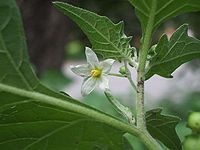
Photo from wikipedia
Studies of local adaptation in populations of chinaberry (Melia azedarach L.) are important for clarifying patterns in the population differentiation of this species across its natural range. M. azedarach is… Click to show full abstract
Studies of local adaptation in populations of chinaberry (Melia azedarach L.) are important for clarifying patterns in the population differentiation of this species across its natural range. M. azedarach is an economically important timber species, and its phenotype is highly variable across its range in China. Here, we collected M. azedarach seeds from 31 populations across its range and conducted a common garden experiment. We studied patterns of genetic differentiation among populations using molecular markers (simple sequence repeats) and data on phenotypic variation in six traits collected over five years. Our sampled populations could be subdivided into two groups based on genetic analyses, as well as patterns of isolation by distance and isolation by environment. Significant differentiation in growth traits was observed among provenances and families within provenances. Geographic distance was significantly correlated with the quantitative genetic differentiation (QST) in height (HEIT) and crown breadth. Climate factors were significantly correlated with the QST for each trait. A total of 23 climatic factors were examined. There was a significant effect of temperature on all traits, and minimum relative humidity had a significant effect on the survival rate over four years. By comparing the neutral genetic differentiation (FST) with the QST, the mode of selection acting on survival rate varied, whereas HEIT and the straightness of the main trunk were subject to the same mode of selection. The variation in survival rate was consistent with the variation in genetic differentiation among populations, which was indicative of local adaptation. Overall, our findings provide new insights into the responses of the phenological traits of M. azedarach to changes in the climate conditions of China.
Journal Title: Genes
Year Published: 2022
Link to full text (if available)
Share on Social Media: Sign Up to like & get
recommendations!